Der Kraut is Sauer!
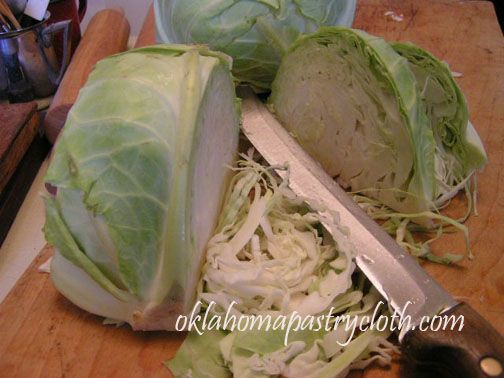
Well, I think that I will venture into the world of German Cuisine and explain the exciting experiment that was performed in the Oklahoma Pastry Cloth™ laboratory.
We made Sauerkraut!! That may not sound exciting to most people, but to me it was a journey into my ancestral past. My grandmother made Sauerkraut in crocks and I have two of those crocks. I’ve been told that they had the additional use of being her knife sharpener. She would turn the crocks over and sharpen her knives on the bottom like on a stone, but I digress.
I never got to watch my grandmother make her Sauerkraut, but I have heard the stories and so, as much as I love the stuff, I decided to see if maybe making it is in my genes! This experiment was prompted by a sale on cabbage at the Firelake Grocery owned by the Absentee Shawnee tribe nearby. 10 lbs for $1! Now THAT’S a sale. I knew that I had to have that cabbage. So what if I had no idea what to do with it? I had to buy it because it is such a steal and it’s wrong to pass up a steal. As I loaded my buggy, I remembered my grandmother’s crocks and my adventure was set.
|
According to Wikipedia, Sauerkraut probably originated in the north of China among the Mongols. That would make sense because one of my favorite Korean dishes is Kimshe which is simply Korean Sauerkraut. Anyway, Sauerkraut was brought to Europe by migrating tribes. Eastern Europeans, eat a LOT of sauerkraut. In Europe, the Jews adopted sauerkraut as part of their cuisine and are thought to have introduced it in the northern countries of Western Europe and then to the United States. Sauerkraut is a staple of the winter diet in Germany and the Netherlands. While sauerkraut is usually prepared with pork, the Jewish people customarily use goose or duck meat.
|
Now came the part in the research that kinda got me. When we had our sheep farm, we raised Sudan Grass and cut it and chopped it and put it into a silo to ferment for the sheep and cows to eat. According to Wikipedia, it’s the same process that is used for Sauerkraut. We’re eating silage!! No wonder those sheep and cows burp so much.
Anyway, when making Silage – I mean – Sauerkraut, you have to be very careful to monitor the temperature of the area where it is fermenting. The USDA says to use more salt than is traditional, but that makes it way too salty. So, in order to avoid food poisoning if using traditional amounts of salt, you must keep the temperature at the correct level. Depending on who you talk to, this should be anywhere between 40 and 70 degrees.
~~~~
Homemade Sauerkraut For One Gallon Crock
5 lbs cabbage
3 1/2 tbsps sea salt or canning salt
1/2 tbsp. carroway seeds (optional)
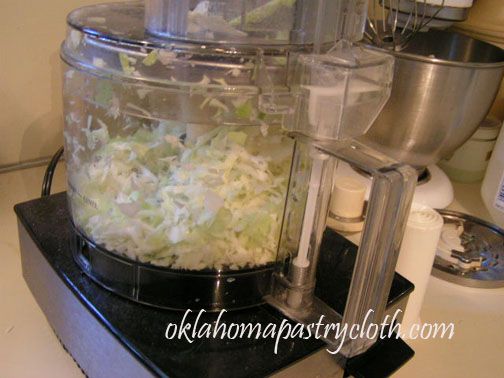
Wash heads of cabbage well and slice thinly with a knife, or if you make no apologies for enjoying the fact that you live in the 21st century, use your food processer with the thin slicing blade.
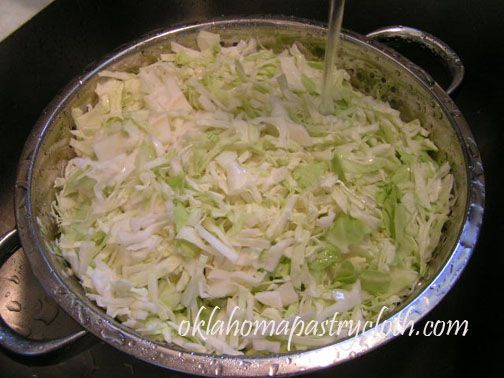
Place in a colandar and rinse to make sure it is very clean.
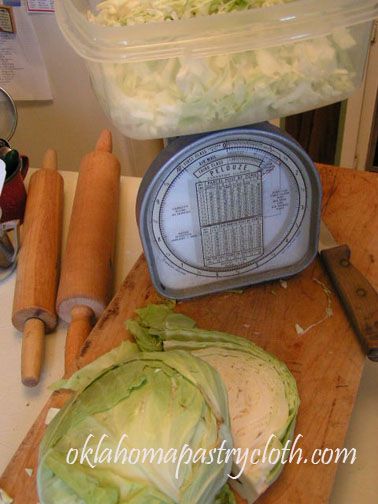
Carefully measure the cabbage to make sure that you have exactly 5 lbs. This is important because the ratio of salt to cabbage has to be very accurate.

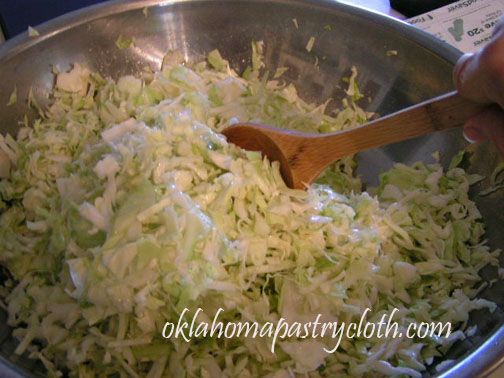
Put approximately 1/3 of the cabbage in a very large bowl and sprinkle approximately 1/3 of the salt. Stir. Add a second layer with another third of cabbage and add more salt. Stir. Add final amount of cabbage and salt and stir well to coat all cabbage with some salt. You can use your hands to mix.
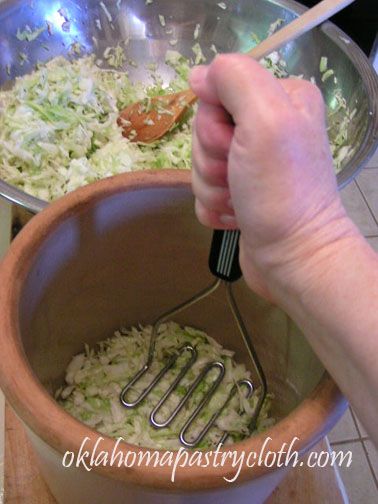
Place about an inch of cabbage in the bottom of a crock and pack down with a potato masher.
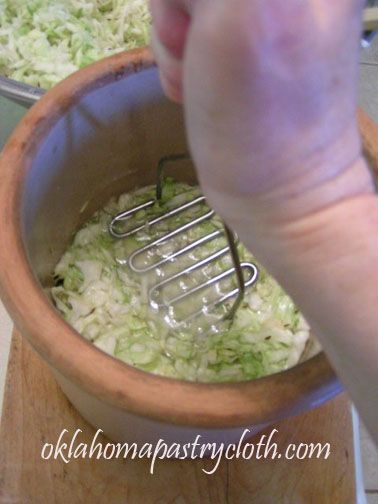
Continue adding cabbage in layers a little at a time, packing down with potato masher each time. As the cabbage is packed tighter and tighter and pressed down, liquid will start forming.
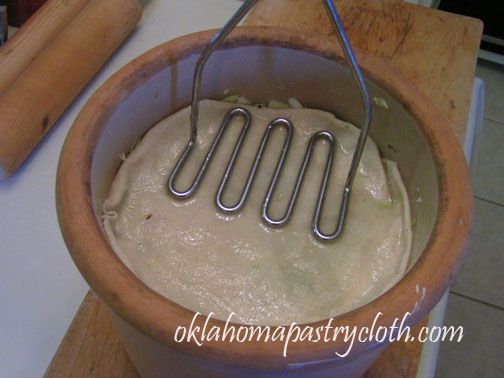
When 5 lbs of cabbage has been packed into the crock, place a piece of cotton cloth on top of the cabbage and pat into the fluid to absorb it while resting on top of the vegetables. The liquid does not rise to the top unless pressure is put on the cabbage.
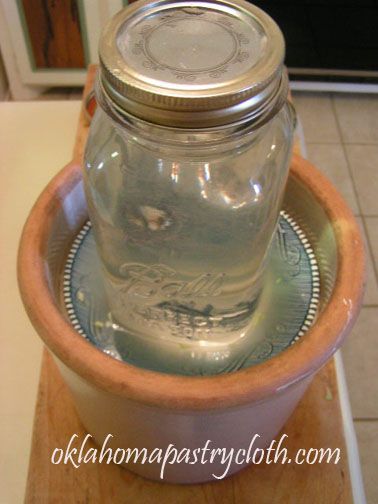
Place a saucer on top of the cloth. Fill a quart jar with water and attach the lid. Place the jar into the center of the saucer. This acts as a weight that keeps the sliced cabbage under the fluid.

Place into a pan and cover with a clean, white cloth. Place in a cool, dry place, where you can monitor the temperature, for 4 to 6 weeks.
This crock was placed in a good ol’ Oklahoma storm shelter with a thermometer on the chair to keep a check on the temps which average between 50 – 70 degrees in the Fall. Every other day, check the crocks for any scum (mold that is harmless) and remove with a plastic spoon by just skimming the surface and scraping the sides of the crock. There should not be much of this mold, but just little dots here and there that can be removed easlily. Check frequently. I check about every other day. During the fermenting process, if evaporation occurs and the fluid level drops, add a cup of water that has been boiled mixed with 1 tsp salt. After the third week, taste the kraut to see how strong it is. Some people begin scooping out a little to eat at this point, but be sure to pack the kraut back down and under the fluid. It is a good idea, for cleanliness, to change the cloth that is directly on the cabbage and wash the plate every few days. I keep a second set of cloths clean and just alternate.
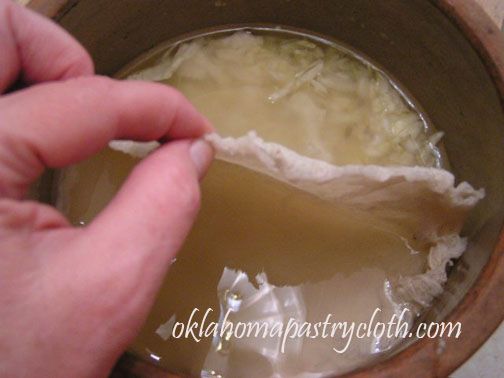
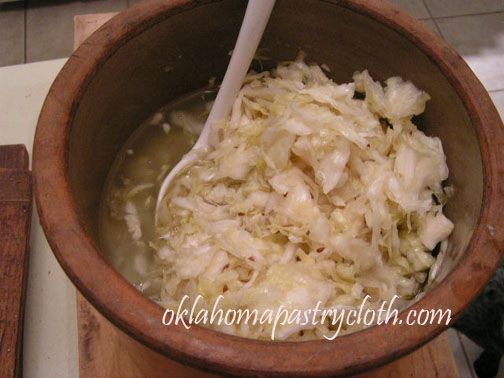
When the kraut has reached the level of tartness that you like, remove the jar and plate and carefully pull up the cloth covering the Sauerkraut. Stir the kraut from bottom up to mix.

You can serve it fresh and it is yummy! To preserve your kraut divide it into freezer bags and freeze it or you can also can it. The following are canning instructions:
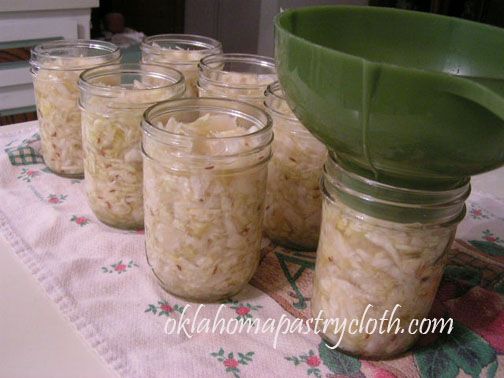
Sterilize canning jars and line up to fill with Sauerkraut, using a slotted spoon to 1/2 inch head space. Pack kraut into jars a little at a time. Add juice over the kraut to fill the gaps.

Keep lids in nearly boiling water. Wipe the top edges of the jars to remove any juices and place lid on jar. Here I am using a canning wand with a magnet to hold the lids.
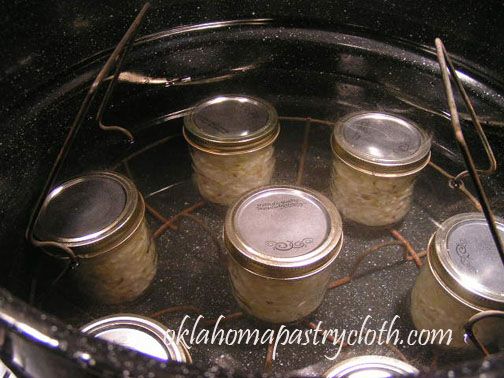
Submerge jars in water in waterbath canner and bring water to a boil. At point of boiling, set timer for 15 minutes. After 15 minutes, lift rack and remove jars to a dry towel to cool. Lids will ping or pop as they seal.
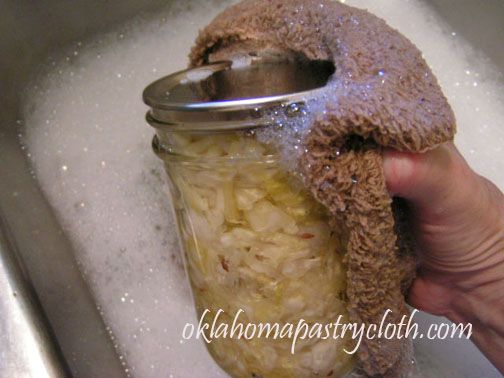
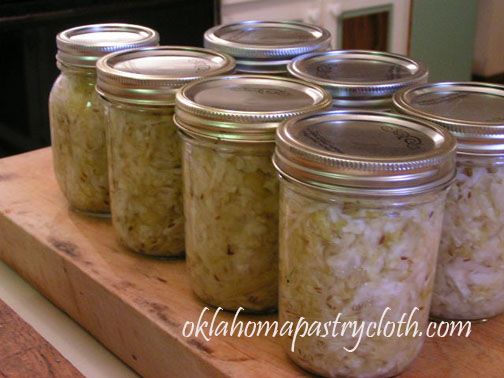
To make your rings last longer and to make your jars nice and clean, when jars are cooled, remove rings and wash in warm, soapy water. Allow to dry totally and return rings to jars or you can store jars without the rings.
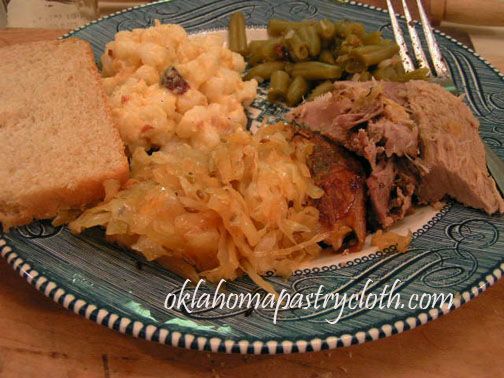
We love pork roast and Sauerkraut. I take any roast, boneless or bone-in and season with salt, pepper, garlic and rosemary and wrap in foil and place it in a baking pan, baking at 350 degrees for about 30 minutes per pound. Length of time varies, but I like the pork to be very, very tender. I remove the roast from the pan and leave about a cup of drippings. I put about an inch layer of Sauerkraut and then slice the pork over the top, and cover with foil. I put that back into the oven for a final 30 minutes and serve with hominy and green beans! Big Smile!!!
And Grandmother’s crocks are still goin’ strong!
Happy Cooking!
MB
|






















 Homestead Revival
Homestead Revival Paratus Familia
Paratus Familia Rural Revolution
Rural Revolution